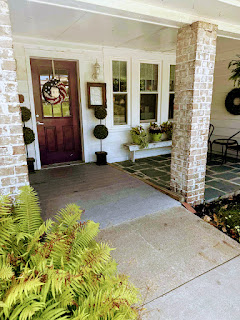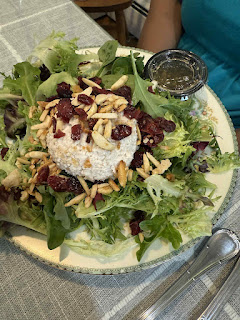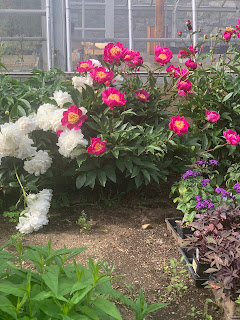There’s something magical about stepping into a tearoom on a sunny afternoon. The promise of delicate china, fragrant tea, warm scones, and good conversation makes afternoon tea one of my favorite rituals. So when our group of nine women decided to book a High Tea at Bella’s Tea House in Havre de Grace, Maryland, I was excited. The photos looked beautiful on the internet and the setting a traditional Tea charm, that I couldn’t wait to experience with my group of family and friends.
But as the afternoon unfolded, what began with a lovely first impression turned into a more complicated experience — one with plenty of potential but some disappointing details.
 |
✨ First Impressions: The tea room is charming and whimsical
Walking into Bella’s Tea House feels like stepping into a storybook. The mismatched china, cozy decor, and vintage touches create a warm, inviting atmosphere. Each table has its own personality, and there’s a playful sense of tradition meets whimsy.
However, once we sat down, that whimsical charm was overshadowed by something less delightful — slightly dirty dishes. Just a couple tea cups and plates at our table had a few speaks of what looked like soot from a candle. Not a huge detail , but nevertheless it gave the impression that the china had been sitting too long.
📅 Booking the High Tea: A Bit Confusing
Because we were a larger group, Bella’s required us to book their High Tea service, which typically includes a soup or starter, a selection of sandwiches, fresh scones, and a tiered dessert tray, all served with tea. They also offer private rooms for groups of ten or more. Make sure to look at the reservation policies especially for groups and make sure you understand deposits, and charges. They also like payment at the end made by one person at the end.
The menu itself was a mix of hits and misses. I did not care for the Broccoli soup, but others liked it. The the sandwiches were forgettable. The biggest disappointment by far was the scones — instead of being light, buttery, and easy to slice, they were rock-hard and difficult to enjoy. The tea selection was fairly small, with about ten choice, but served in large teapots. There was no introduction or explanation of the tea blends. I missed that personal touch that elevates a tea service into an experience. It is commonly mussing from many tea rooms. Also it is mostly focused on serving tea, not retailing it. Unless I just did not see tea to purchase.
🪻 The Atmosphere: Cozy, but a little Cluttered
Bella’s interior is undeniably cute and cozy, but it borders on too a little too much decor. The abundance of decor makes the space feel cluttered rather than calm, and I found it slightly overwhelming rather than relaxing. It’s a style some guests might love, but I wished for a cleaner, more tranquil setting to match the elegance of afternoon tea.
🌿 A Little About My Tea Background
I should share a little context, because my love for tea — and my expectations — come from many years of both personal and professional experience.
I grew up in London, England, where tea is part of daily life, and I’ve been drinking and serving tea for as long as I can remember. When I owned my spa business years ago, I offered a complimentary tea service and lunch in partnership with a tearoom next door called The Escape, where we paired treatments with afternoon tea. Our Spa and tea experience was even featured in The Plain Dealer Magazine at the time.
I also collaborated with a charming bed and breakfast called The Emerald Necklace, where I offered facial services during their tea parties when my business was first starting out. Those experiences deepened my belief that tea isn’t just a drink — it’s part of a ritual of care, connection, and relaxation.
☕ Final Thoughts
My afternoon at Bella’s Tea House was a mix of lovely ideas and disappointing execution. The space is charming and full of character, but the details — from cleanliness and communication to the freshness of the food and quality of the tea — need more care.
With more attention to these details, Bella’s has the potential to become a truly special destination for tea lovers in Havre de Grace. As it stands now, it’s a charming spot with a lot of potential that just didn’t quite deliver the magical tea experience I was hoping for.
⭐ Overall Rating: 3 out of 5
A sweet and whimsical tearoom with heart and potential, but the experience fell short in key areas.
and quality of the tea — need more care.
With more attention to these details, Bella’s has the potential to become a truly special destination for tea lovers in Havre de Grace. As it stands now, it’s a charming spot with a lot of potential that just didn’t quite deliver the magical tea experience I was hoping for.
⭐ Overall Rating: 3 out of 5
A sweet and whimsical tearoom with heart and potential, but the experience fell short in key areas.
✅ Pros
-
Charming, storybook atmosphere
-
Generous dessert platter
-
Great spot for group gatherings
-
Offers private rooms for larger parties
❌ Cons
-
Dirty china and lack of attention to detail
-
Charged for extra guest despite lower headcount
-
Rock-hard scones and average sandwiches
-
Tea quality inconsistent, with no presentation or explanation
-
No retail tea available



.jpeg)















































